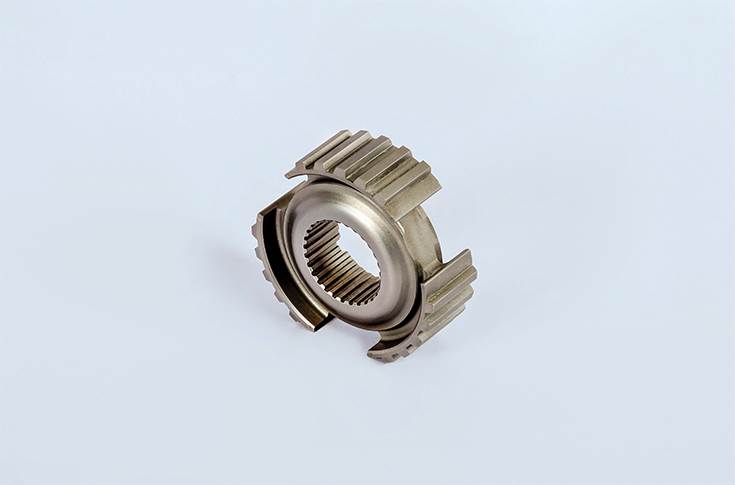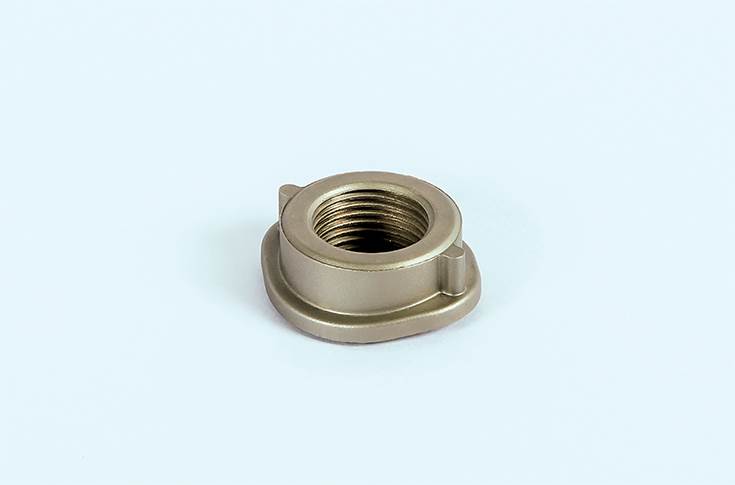Sintercom India to ride growing demand for lightweight components
Sintercom India is bullish on the growing demand for lightweight sintered components as the local market is increasingly embracing global technology benchmarks.
Sintercom India, a Talegaon-based Rs 75 crore manufacturer and supplier of sintered components to the automotive industry, is bullish on the growing demand for lightweight sintered components as the local market is increasingly embracing global technology benchmarks.
As weight reduction is increasingly becoming one of the core parameters, just like the cost targets, in the vehicle design and development processes, OEMs, as well as suppliers, are now exploring ways to slash kilos across different areas in vehicles. Driving this trend are the incoming new technology mandates, primarily BS VI and CAFE norms (in India) and vehicle electrification.

Gear Balancer Idler
Banking upon the trend of cutting down vehicle weight, the Talegaon-based, eight-year-old Sintercom India is eyeing rapid growth over the next few years. The company’s top management is targeting almost four-fold growth over the next five to six years. Jignesh Raval, MD, Sintercom India, who was one of the early employees at Tenneco India and instrumental in setting up the local operations for the US-based Tier 1 supplier, had set up Sintercom as a greenfield project in 2010.
Raval, with 26 years of experience in the automotive industry, figured there was a sweet spot in the potential demand for the medium to high-density sintered components across various applications. “I was heading the APAC region’s global supply chain, and customer and supplier quality worldwide, primarily looking into the sourcing (of materials) from low-cost countries such as India in my previous assignment. That’s when, I believe, while dealing with commodities and their strengths and weaknesses, I conceived the scope of technologies around sintered materials,” recounts Raval.

Synchro hub (fifth speed)
He believes that the application of the technology (of sintered parts) is lagging behind in India (across industries including automotive). It is understood that although companies such as GKN and Sundram Fasteners are prominent names among the suppliers of sintered components in India, Raval says that the existing players focus only on the 6.5 – 6.8 density sintered parts.
“Our strength is medium to high-density sintered products. We started our journey with 6.9 and above density products only. As of today, more than 90 percent of our products offer density of 6.9 and above. We produce products with up to 7.3 density. We are now investing in Denscal, which is a rolling operation wherein we increase the density to up to 7.7,” states Raval while explaining how Sintercom’s product portfolio is unique.

Oxygen sensor boss
Interestingly, the company was awarded with supply orders from Fiat for its Jeep Compass SUV recently for its zero backlash gear technology.
What are sintered components?
Sintered components manufactured and supplied by Sintercom India are made of metal powder. A process known as sintering process performs compacting operations on the metal powder by applying heat or pressure. In general, sintered components can be made of plastics, ceramics and other materials, besides metals.
Sintered components are finding applications in the automotive industry in areas wherein they can replace existing forged metal parts. The increasing applications of sintered components can be seen across the vehicle architecture, primarily around the engine, transmission and body chassis areas. It is understood that sintered components provide weight savings as well as lower costs – two key aspects driving the auto industry value chain in the wake of multiple technology trends worldwide.

Sprocket crankshaft
Explaining how and where the sintered components are finding traction in automobiles, Raval explains, “In any functional mechanical joint, only 30 percent of the product gets the impact load. This means that the remaining 70 percent is not required to bear the impact load. So only 30 percent of such joints require forged components and the remaining 70 percent can be sintered parts. The latter cannot bear the impact load when compared to the forged parts. This is because the elongation (in sintered parts) is very low. While in forged components, one can get up to 30-33 percent elongation, in the sintered parts you will get up to 4-5 percent. In reality, a lot of areas can use sintered components, which do not need to bear impact load. Instead, they (sintered components) need to be wear resistant. That can be achieved through the higher density, and that’s what our technology is about.”
He further adds, “This is a 100 percent green technology because it is recyclable. The metal powder that is used to make sintered components can come from recycled scrap metal and can be sourced from approved smelters. The powertrain parts that we are producing see zero replacement through the life of the vehicle.”
Currently, four types of sintering processes are known globally: conventional sintering, isostatic sintering, metal injection moulding and additive manufacturing. Sintercom India currently deploys the conventional sintering processes at its plant at Talegaon. “While currently we manufacture sintered parts using only the conventional sintering processes, we have a huge scope for further expansion via other forms of sintering processes,” says Raval.

Threaded stub
Sintered components are used in the automotive, aerospace, consumer goods and medical equipment industries. One of the early products manufactured and supplied by Sintercom India was Hego Boss, which has application in the exhaust systems. The company exported these parts too.
Benefits of sintered components
Sintercom India has helped Mahindra & Mahindra (M&M) in terms of replacing the existing chain-drive sprockets in the UV maker's vehicles from forged to sintered parts.
In 2011, the company approached Bajaj Auto and helped it replace a few forged gear parts such as driven and idler gears with their sintered counterparts, which have application in small-displacement motorcycle engines.
Sintercom India continues to increasingly engage with OEMs and suppliers as lightweighting is gaining traction across the automotive value chain.
Raval believes that adhering to the incoming BS VI emission norms is the main driver behind lightweighting across the automotive value chain. “Weight reduction is one of the biggest challenges that most engineers in the R&D are staring at. Our technology is helping them to achieve their weight reduction targets in critical parts. Besides weight savings, the benefits of sintered components are that the repeatability of dimensions is much stable when compared to the other forms of machining processes, and in certain cases we can create different shapes also,” he says.
Explaining why sintered components are lighter in weight, he states, “The sintered parts are lighter in weight when compared to their conventional counterparts because of lower density. The density of sintered parts is in the range of 6.7 to 7.2, which replaces the 7.8 and above density of the forged parts. The weight reduction achieved ranges from 5 to up to 12 percent in certain cases. For example, in one of the programs for M&M, we have managed to reduce the weight by up to 9 percent of the bearing cap in this case.”

Jignesh Raval: "We are now investing in Denscal, which is a rolling operation wherein we increase the density up to 7.7."
Citing another example, Raval threw light on how synchro hubs manufactured by Sintercom India provided scope of additional lightweighting in a critical part used in the transmission assembly.
“For M&M recently, our synchro hub (each unit) provides about five percent weight reduction. Furthermore, the design (of the synchro hubs) is more suitable enabling better oil circulation as compared to the earlier design of the replaced part. To understand total weight savings on this part, about four synchro hubs would be required in a six-speed transmission system. However, this is subjective and largely depends upon the individual design assemblies,” he highlights.
Eyeing the CV market, ready for electric vehicles
To fuel its future growth, Sintercom is now revising its strategy for the commercial vehicle segment. The company used to supply to BharatBenz few years ago.
Talking in this context, Raval shares, “We are now looking at CVs as per our new growth strategy. We used to supply the ABS rings to BharatBenz earlier. However, earlier the volumes were very low. These rings are now mandatory as the ABS units are required as mandatory fitment. We are looking at the segment again because the CV volumes are now picking up. We are approaching major CV OEMs including Tata Motors, Ashok Leyland and others.”
The company appears immune as well as ready for the incoming megatrends of electric and hybrid vehicles. According to the top company official, it has sintered components in its basket of products that can be used by electric vehicles. “The technology of sintered components is proven for electric vehicles. We are ready for that. There will be sintered components used in an electric car as well. Nonetheless, if hybrid vehicles become mainstream, it is even better from the point of view of the volume of sintered components used per vehicle,” states Sintercom India’s MD.
According to him, sintered components used in areas such as planetary gearbox, electric steering parts, electric magnets and others are used in electric vehicles, and these can be locally manufactured and supplied to the OEMs when needed in the future.
Market size of sintered components
Raval says the overall market size of the sintered components in the auto industry is pegged around Rs 1,800 crore. By 2020, this will exceed Rs 2,000 crore solely on the back of demand of these components from OEMs in India. “There are a lot of products supplied to Tier 1 suppliers also. This forecast does not include the potential demand from the Tier 1s in the near future,” he adds.

Sintercom manufactures medium and high-density sintered products. Their density varies between 6.9 to 7.3, thereby providing good scope for weight and cost reduction.
Raval estimates that Sintercom’s market share in total supplies of sintered components in India stood at about 7 percent as on March 31, 2018. It expects to touch 10 percent of this growing market by FY2020. “This growth is accounted for as per the current order book. I would estimate about 55-60 percent of the market for synchro hubs is with Sintercom currently. We supply these to M&M, Maruti Suzuki and others,” he says.
Sintercom also supplies about 3,200 synchro hubs every day to Maruti Suzuki at its Gurgaon plant.
The company, which has recorded a CAGR of 18 percent over the last five years, has seen aggressive growth since 2015 of a CAGR of 27-28 percent. Now the top management is eyeing a CAGR of about 25 percent till 2024.
The company has a joint venture with Austria’s MIBA, a 752 million euro supplier of sintered components to the global auto industry. “The JV was formed in 2011. After Sintercom’s IPO last year, MIBA holds about 20 percent in Sintercom India,” he says.
Reflecting on the JV partner’s growth, Raval underlines that “MIBA has grown from 130 million euro turnover (from sintered parts) in 2011 to 400 million euro revenues (from sintered parts) now.”
Meanwhile, in India, Maruti Suzuki is Sintercom's largest customer while other prominent OEM customers include M&M and Bajaj Auto. The company has invested about Rs 110 crore as of 31 March 2018 in setting up its plant and operations. “We bought a 5-acre land parcel, which provides us enough scope for future expansion. We invested with a long-term outlook. The investments made specifically in the plant and machinery are around Rs 70 crore of the total investments made until now,” Raval adds.
The company’s capex stands at about 10 percent of its annual revenues, which stands at about Rs 6-7 crore. In FY2019, it is investing about Rs 16 crore on capacity expansion. The bulk of this investment is being made on inducting new capital equipment in the plant. The capex allotted every year also goes into new technology and innovation and in new product development.
“I would say that about 2 percent of the annual revenues go into new product development. This year, FY2018-19, it could be higher (over two percent) than previous years,” reveals Raval.
Furthermore, he updates, “we require this additional capacity next year. But we are getting ready for it this year. We are expanding capacity from 1,900 tonnes to 3,600 tonnes and from 9.4 million strokes to 12 million strokes. We have a capacity expansion roadmap that underlines when in future we will require to have an installed capacity for 14 million and later 16 million strokes at our plant. We have to advance our capacity by at least six months in advance. That’s how we work. Typically we look at 75-80 percent capacity utilisation. Whenever it crosses 85-90 percent utilisation, we add new capacity.”
(This feature was first featured in the October 1, 2018 issue of Autocar Professional)
RELATED ARTICLES
BluWheelz to 'Green Up' logistics sector
With their EVs-as-a-service solution, the startup is playing it smart with costs and looking to electrify the entire seg...
BRANDED CONTENT: Spearheading the EV revolution in India
Jio-bp is a joint venture between Reliance Industries and BP PLC where both entities have married international expertis...
Qualcomm devises cost-effective ADAS chip for India
The American technology giant is enabling connectivity in modern cars and aims to tap into the price-conscious Indian ma...





 By Autocar Pro News Desk
By Autocar Pro News Desk
 15 Dec 2018
15 Dec 2018
 13600 Views
13600 Views









